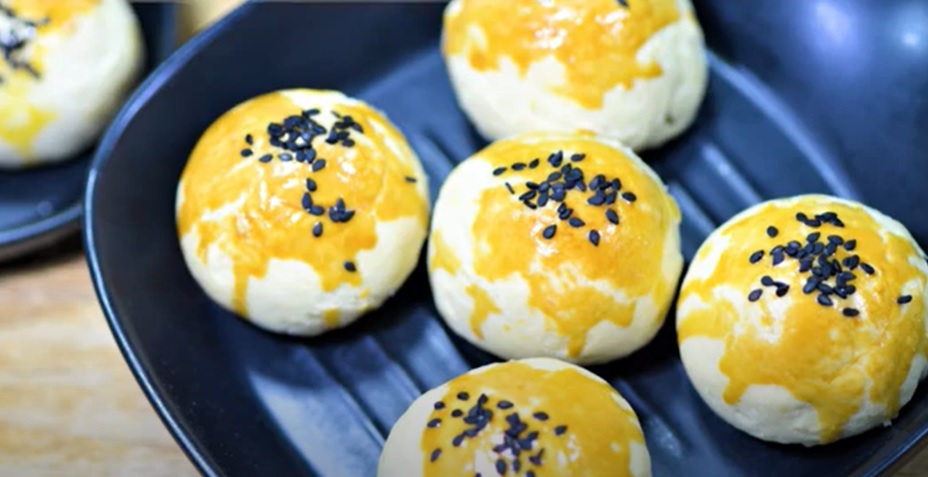
Introduction:
豆沙饼食谱介绍
Tau Sar Piah/ Tambun biscuit, a beloved traditional pastry, offers a delightful combination of flaky, buttery layers and a sweet, mung bean filling that’s bound to tantalize your taste buds. This time-tested recipe for Tau Sar Piah guides you through the art of creating these delectable treats from scratch. With two distinct layers – an oil-rich outer shell and a water-based inner skin – these pastries offer a unique textural contrast that complements the creamy mung bean paste at their heart. Join us as we embark on a culinary journey to recreate this classic snack, where the aroma of freshly baked goods fills the air, and the satisfaction of enjoying a homemade treat awaits. Whether you’re a seasoned baker or just starting your culinary adventure, making Tau Sar Piah from scratch is a rewarding endeavor that will leave you craving more. So, let’s roll up our sleeves, gather our ingredients, and begin crafting these irresistible Tau Sar Piah pastries to share and savor with family and friends.
豆沙饼,一款备受喜爱的传统点心,以其酥脆、黄油味浓的外皮和香甜可口的绿豆沙馅而闻名遐迩。这份经典的豆沙饼食谱将引导您从零开始制作这款美味的点心。豆沙饼的制作包括两个独特的层次——外层是油皮,内层是水油皮,它们相互交织,与内心的滑嫩绿豆沙相得益彰。随着新鲜烘烤的香气弥漫开来,享受自制美食的满足感近在咫尺。无论您是经验丰富的烘焙师傅,还是初入厨房的新手,自制豆沙饼都是一项值得尝试的美好冒险,让您尽情品味这款经典点心。那么,让我们一起动手,准备好食材,开始制作这款令人垂涎的豆沙饼,与家人和朋友一同分享和品味。
Ingredients:
Oil Skin:
65g Low-Grade Flour
35g Butter
Water Base Skin:
80g Low-Grade Flour
25g Butter
25g Water
1g Salt
20g Sugar
160g Mung Bean Paste
1 Egg Yolk
3g Black Sesame Seeds
材料:
油皮:
- 65克低筋面粉
- 35克黄油
水油皮:
- 80克低筋面粉
- 25克黄油
- 25克水
- 1克盐
- 20克糖
- 160克绿豆沙
- 1颗蛋黄
- 3克黑芝麻
Intruction:
1. Oil Skin: In a mixing bowl, combine 65g of low-grade flour and 35g of butter. Knead the mixture until it forms a smooth dough. Allow the dough to rest for 30 minutes.
2. Water Base Skin: . In another mixing bowl, mix 80g of low-grade flour, 25g of butter, 25g of water, and 1g of salt. Knead the dough until it becomes smooth. Then, add 20g of sugar and knead until the sugar is well incorporated. Let the dough rest for 30 minutes.
3. Divide the mung bean paste into 20g portions.
4. Divide the oil skin dough into 12.5g portions and the water base skin dough into 18.5g portions.
5.Take a portion of the water base skin and wrap it around a portion of the oil skin.
6. Roll it into a ball shape and let it rest for 10 minutes.
7. Roll the dough into a long shape, then roll it up. Repeat this process once more.
8. Wrap the dough around the mung bean paste to encase the filling.
9. Double egg wash the biscuit by brushing it with egg yolk and sprinkling some black sesame seeds on top.
10. Preheat your oven to 180°C and bake the Tau Sar Piah for 25 minutes.
11. Allow to cool before serving.
制作方法:
油皮: 1.在一个搅拌碗中,将65克低筋面粉和35克黄油混合在一起。揉搓混合物,直到形成光滑的面团。让面团静置30分钟。
水油皮: 2. 在另一个搅拌碗中,混合80克低筋面粉、25克黄油、25克水和1克盐。揉搓面团,直到变得光滑。然后,加入20克糖,揉搓至糖完全融合。让面团静置30分钟。
- 将绿豆沙分成每份20克。
- 将油皮面团分成每份12.5克,水油皮面团分成每份18.5克。
- 取一份水油皮,包裹在一份油皮周围。将其滚成一个球状,让其静置10分钟。
- 将面团擀成长条形,然后卷起。重复此过程一次。
- 将面团包裹在绿豆沙馅周围,将馅料完全封入。
- 使用蛋黄液对豆沙饼进行双层涂抹,然后在顶部撒上一些黑芝麻。
- 预热烤箱至180°C,然后将豆沙饼烤25分钟。
- 在享用前让豆沙饼冷却。
Video
More Video
The History Tau Sar Piah
Tau Sar Piah, also known as Tambun Biscuit, is a delectable pastry with a rich history that spans several generations. This beloved treat has its roots in the cultural melting pot of Southeast Asia, where it has become an iconic delicacy.
The story of begins in the town of Tambun in Penang, Malaysia. Tambun has a long history of Chinese migration, and it is within this vibrant community that the pastry found its earliest origins. The name “Tau Sar Piah” itself is derived from the Hokkien dialect, where “Tau Sar” means mung bean, and “Piah” means biscuit or pastry.
It is believed that it was first introduced by Chinese immigrants who settled in Penang during the 19th century. These early Chinese settlers brought with them their culinary traditions, and over time, they adapted their recipes to suit the local ingredients and tastes.
The key element that makes it unique is the mung bean paste filling. Mung beans are ground into a smooth, sweet paste and then flavored with a hint of salt and sugar. This mixture is then wrapped within layers of flaky pastry to create a delightful contrast of textures and flavors. The process of crafting the perfect mung bean paste filling has been refined and perfected over generations, resulting in the irresistible taste that defines Tau Sar Piah.
It quickly gained popularity not only within the Chinese community but also among Malaysians of various backgrounds. As its reputation grew, it became a sought-after souvenir for visitors to Penang. The biscuit’s appeal transcended cultural boundaries, making it a beloved treat for everyone.
In addition to its flavor, it is also known for its unique appearance. Traditionally, the pastry is characterized by its round shape and a distinctive pattern on the top crust, which is often imprinted with the bakery’s name or logo. This not only adds to the biscuit’s visual appeal but also serves as a form of branding for the bakeries that produce them.
Over the years, many bakeries in Penang have become renowned for their Tau Sar Piah, each with its own secret recipe and distinct style. These establishments have become institutions in their own right, drawing locals and tourists alike to savor these delectable pastries. Visitors to Penang often make it a point to visit these iconic bakeries, ensuring that it remains an integral part of the state’s culinary heritage.
Today, it has not only remained a beloved Malaysian delicacy but has also gained recognition on the international stage. Its unique combination of flavors and textures has garnered a devoted following beyond Malaysia, making it a sought-after souvenir for travelers who want to take a piece of Penang’s culinary heritage back home.
In conclusion, the history of Tambun Biscuit, is a testament to the enduring legacy of culinary traditions passed down through generations. Its humble beginnings in Tambun, Penang, have evolved into a symbol of Malaysian culture and a treat that delights people of all backgrounds. As Tau Sar Piah continues to be enjoyed and cherished, it is a reminder of the cultural richness and diversity that has shaped the Malaysian culinary landscape.
豆沙饼(Tambun饼)的历史
豆沙饼,也被称为Tambun饼,是一款美味点心,拥有跨足多代人的丰富历史。这个备受喜爱的美食拥有深厚的文化底蕴,成为了东南亚文化融合的象征。
豆沙饼的故事始于马来西亚槟城的丹绒镇。丹绒有着悠久的华人移民历史,正是在这个充满活力的社区里,这款点心找到了最早的起源。”豆沙饼”这个名字来源于福建话,其中”豆沙”意为绿豆,”饼”则代表饼干或点心。
人们相信,豆沙饼最早是由19世纪定居在槟城的华人移民引入的。这些早期的华人移民携带了他们的烹饪传统,随着时间的推移,他们逐渐适应了当地的食材和口味。
使豆沙饼独特的关键元素是绿豆馅料。绿豆被磨成光滑、甜美的糊状,然后加入少许盐和糖调味。这个混合物随后包裹在多层酥皮中,创造出纹理和口味的愉悦对比。制作完美绿豆馅的过程在几代人中不断完善,最终形成了令人垂涎的豆沙饼味道。
豆沙饼迅速赢得了不仅华人社区,还包括马来西亚各族群之间的普遍欢迎。随着声誉的提高,它成为了前往槟城的游客们渴望带回的纪念品。这款点心的吸引力跨足了文化界限,成为了每个人都喜欢的美食。
除了口味,豆沙饼还以其独特的外观而著称。传统上,饼干以其圆形和独特的上层酥皮上的花纹而闻名,通常刻有面点店的名称或标志。这不仅增加了饼干的视觉吸引力,还作为面点店的品牌形象。
多年来,槟城的许多面点店因其豆沙饼而闻名,每家面点店都有自己的秘方和独特的风格。这些面点店已经成为地方的代表,吸引着当地居民和游客前来品尝这些美味的点心。前往槟城的游客通常特意前往这些标志性的面点店,确保豆沙饼仍然是该地的烹饪遗产中不可或缺的一部分。
如今,豆沙饼不仅保持着马来西亚人的喜爱,还在国际舞台上获得了认可。其独特的口味和质地组合已经吸引了国际上的一批忠实粉丝,使其成为了希望将槟城的烹饪传统带回家的旅行者的首选纪念品。
总之,豆沙饼,或称Tambun饼,的历史是传承多代的烹饪传统不朽的见证。它在槟城的谦卑起源已经演化为马来西亚文化的象征,成为了一种受人喜爱的美食,无论种族背景如何。随着豆沙饼继续被人们喜爱和珍惜,它是对文化丰富性和多元性的一种提醒,塑造了马来西亚的烹饪景观。
